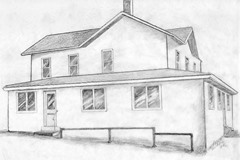Home Humidity
Winter is setting in across the country and many homeowners are experiencing the effects of this change upon their home humidity. Pros know the importance of regulating indoor humidity, especially during months when furnaces are working overtime. Too little moisture in the air and skin dries out, paint cracks and static electricity discharges. Too much moisture and windows fog up, mold grows and wood floors and furniture will expand.
Maintaining the correct levels of indoor humidity also affects how warm or cool people feel in their homes. The EPA recommends an indoor humidity between 30 and 50 percent.
“Humans are very sensitive to humidity, as the skin relies on the air to get rid of moisture. The process of sweating is your body’s attempt to keep cool and maintain its current temperature. If the air is at 100 percent relative humidity, sweat will not evaporate into the air. As a result, we feel much hotter than the actual temperature when the relative humidity is high. Your shirt may become saturated with perspiration that doesn’t go anywhere, leaving you feeling like a swampy bog monster of revolting proportions. If the relative humidity is low, we can feel much cooler than the actual temperature because our sweat evaporates easily, cooling us off.” (howstuffworks)
How Humidity is Measured
Maintaining proper home humidity can be a bit of a complicated process that starts with understanding what humidity even is. There are three main ways that humidity is measured:
“Relative Humidity – This quantity tells us how close the conditions are to saturation, when condensation of water vapor can occur. The interaction of porous materials with water vapor increases with increasing RH. The chance of growing mold increases with increasing RH, 70% usually given as the threshold to stay below.
Dew Point Temperature – This temperature scales with the amount of water vapor. As more water vapor enters a volume, the dew point goes up. If the air in your crawl space, for example, has a dew point of 75° F, you’re probably going to find condensation somewhere. Look at the water pipes, poorly insulated ducts, and uninsulated duct boots.
Wet Bulb Temperature – If dew point is the temperature of condensation, wet bulb is the temperature of evaporation. Same concept; different direction. This one’s important for cooling our bodies.” (EnergyVanguard)
These measurements are compared to each other in order to produce a more accurate view of what’s happening with the moisture in the air.
“Wet bulb temperature is the lowest temperature to which air can be cooled by the evaporation of water into the air at a constant pressure. It is therefore measured by wrapping a wet wick around the bulb of a thermometer and the measured temperature corresponds to the wet bulb temperature. The dry bulb temperature is the ambient temperature. The difference between these two temperatures is a measure of the humidity of the air. The higher the difference in these temperatures, the lower is the humidity.” (sciencedirect)
If your brain is exploding, here’s a different way of putting it:
“Consider a thermometer wrapped in a water-moistened cloth. The drier, less humid the air, the faster the water will evaporate. The faster water evaporates, the lower the thermometer’s temperature will be relative to air temperature.
But water can only evaporate if the air around it can absorb more water. This is measured by comparing how much water is in the air, compared to the maximum which could be in the air—the relative humidity. 0% means the air is completely dry, and 100% means the air contains all the water it can hold in the present circumstances and it cannot absorb any more water (from any source).
This is why we feel cooler in dry air. The drier the air, the more moisture it can hold beyond what is already in it, and the easier it is for extra water to evaporate. The result is that sweat evaporates more quickly in drier air, cooling down the skin faster. But if the relative humidity is 100%, no water can evaporate, and cooling by sweating or evaporation is not possible.
When relative humidity is 100%, a wet bulb thermometer can also no longer be cooled by evaporation, so it will read the same as an unwrapped thermometer.” (wikipedia)
For more info on this fascinating matter (including diagrams!), click here.

